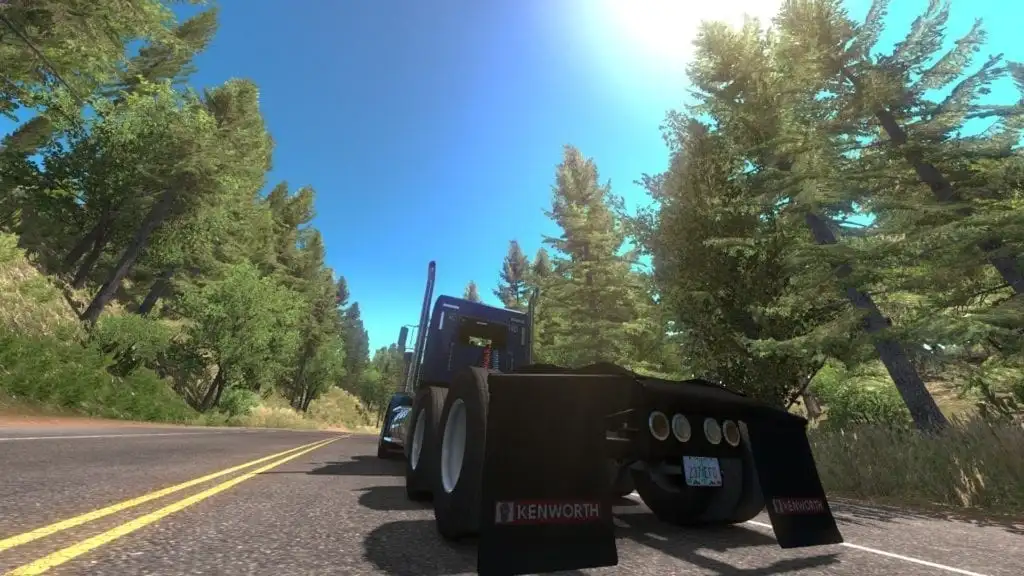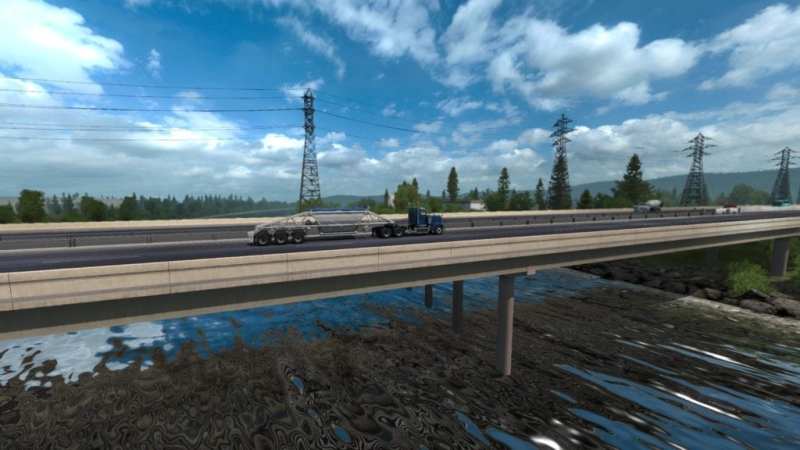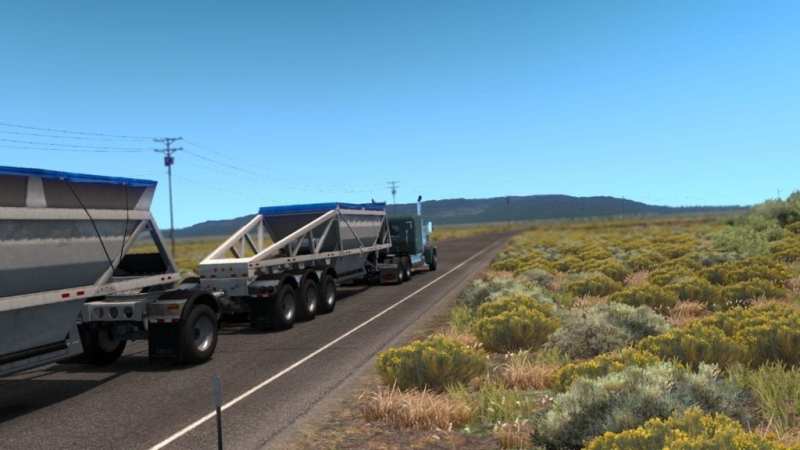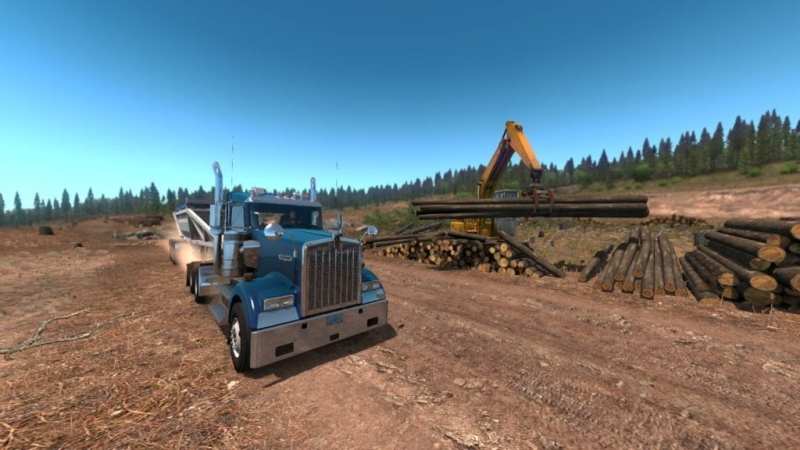In the past, I’ve grilled the landscape of American Truck Simulator due to it mostly being a huge swath of dry, rocky terrain. Sure, that’s geographically correct, considering that its map consists of some of the driest states in the USA. But it was a bit of a letdown when compared to its sibling, Euro Truck Simulator 2, which has miles and miles of scenic greenery. But, now things are beginning to change for ATS after the arrival of the new Oregon map expansion. Called the ‘Beaver State’, its representation in American Truck Simulator has shown me exactly why it has such a nickname.
Oregon stands out from the four other states in ATS almost immediately. Unlike those, acres upon acres of thick, dense woodlands fill Oregon’s boundaries, accompanied by large rivers, lakes, and streams. Thus, it should come as no surprise that a good chunk of the cargo that’s available to haul is related to logging and forestry (which is part of the reason it has the name ‘Beaver State’).
It’s been fun rolling through the uneven terrain of the forest trails; you don’t find yourself often going off-road otherwise in American Truck Simulator. As I made my way through the fourteen major settlements on the map, I immediately noticed how much greener Oregon is in comparison to the other states. There are some drier, browner areas here and there. But, even the sparser patches of Oregon’s terrain contain a lot of shrubberies. They’re usually not too far from a forest, either.
Like the other states, Oregon also contains a lot of hills, although overall it does appear to be smoother than the others. California, Arizona, and Nevada, in particular, all have more mountainous regions. Still, Oregon does have its fair share of gradients and winding hillside roads which can keep you on your toes as you try to navigate them.
One with nature
But, you’ll likely spend the majority of your time gawking at all the natural scenery. Bridges are aplenty in Oregon, so it has become quite soothing to take in all of the water. Not to mention I even saw a geyser along one of the routes. Along with all of the aforementioned woodlands, there’s some nice farmland too. Seeing the open fields straddled by the short hills in the distance was a thing of beauty. Indeed, it doesn’t matter where you drive in Oregon. You could consider just about any and everywhere to be the ‘scenic route’.
Considering how green Oregon is compared to other parts of American Truck Simulator, I guess I shouldn’t have been surprised by how much it rains. During my six-hour playthrough of driving through the state, I must have gotten caught up in a rain shower at least 30% of the time. Even after altering the rain probability down to a fairly low value, showers still popped up quite frequently. Guess that’s what I get for complaining about how dry the rest of the map is.
As for man-made marvels, Oregon continues to impress. None of the state’s major cities are anywhere near as big as the likes of mega-metropolises like LA, San Francisco, and Vegas. In fact, I’d say they mostly look like larger towns. But, you do have some genuine small towns and villages dotted throughout the state. They aren’t named on the map itself, but they all have nameplates along the roadside.
The architecture of these small towns stands out, as they all have a rustic, ‘old-timey’ look to them. Even a lot of the cars are from a few decades ago. Mix that in with the aforementioned farmland, and a lot of the scenes end up looking like they’re from some country film out of the 70s. That’s not at all a complaint; it’s just to emphasize the type of atmosphere that Oregon has. Minus the larger cities like Portland, most of Oregon’s architecture blends in with the nature surrounding it. It’s no wonder why I couldn’t stop taking pictures throughout my journey.
Keep your eyes on the road
The scenery designers over at SCS Software need a pat on the back for this one. The level of detail in just about every area of the state is simply amazing. Each settlement feels “alive”, as there’s constant movement. Not only do you have the AI traffic, but little details like kids in a skate park and lumber yards all have actual animations applied to them. The texture work of all the buildings is also quite detailed, with the older towns truly looking like they’ve been there for eons.
I forgot to mention how Oregon also has an extensive railroad network, and it’s replicated in American Truck Simulator. As such, you’ll constantly see cargo trains and passenger trams rolling around. There was even a moment where I was bolting down a highway and a train rolled around the bend at the same time. It created this almost cinematic scene where we were driving along in unison. Again, the attention-to-detail is simply astounding. It truly makes me appreciate all the painstaking effort that has gone into it all.
Just about the only thing I didn’t like about Oregon is how small it is. Now, of course, the developers couldn’t do much about this: Oregon is simply a smaller state than the others. In fact, so far it’s the smallest state in the whole game. As mentioned before, I only needed about six hours to drive to all fourteen of the settlements on the map.
Still, seeing road signs pointing to yet-to-be-included areas like Seattle, Washington, and Vancouver, Canada, makes me yearn for American Truck Simulator’s map to be expanded further north—where it gets even more green. But alas, SCS has not yet mentioned what’s next on the agenda. They could decide to go further east like they did last year with the New Mexico expansion. Only time will tell. Speaking of time, it’s still kind of hard to believe that the world of American Truck Simulator has grown by only two states since its initial launch in 2016. But, taking into consideration how meticulously detailed the game’s world is, it’s no wonder why SCS takes their sweet time putting these maps together. That said, I cannot wait to see where American Truck Simulator goes next.
A review code was provided by the publisher.










Published: Oct 9, 2018 12:39 pm